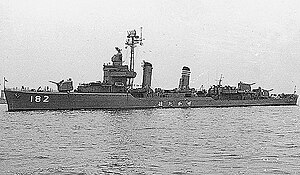 JDS Hatakaze in 1960s JDS Hatakaze in 1960s
| |
| Class overview | |
|---|---|
| Name | Asakaze-class destroyer |
| Builders | |
| Operators | |
| Preceded by | N/A |
| Succeeded by | Ariake class |
| Subclasses | Gleaves class |
| Built | 1940 |
| In commission | 1954–1969 |
| Completed | 2 |
| Retired | 2 |
| General characteristics | |
| Type | Destroyer |
| Displacement |
|
| Length | 348 ft 3 in (106.15 m) |
| Beam | 36 ft 1 in (11.00 m) |
| Draft | 13 ft 2 in (4.01 m) |
| Installed power |
|
| Propulsion | 2 shafts |
| Speed | 37.4 knots (69.3 km/h; 43.0 mph) |
| Range | 6,500 nmi (12,000 km; 7,500 mi) at 12 knots (22 km/h; 14 mph) |
| Complement | 16 officers, 260 enlisted |
| Armament |
|
The Asakaze-class destroyer is a class of destroyers of the Japan Maritime Self-Defense Force. Two ships of the Gleaves class were lent by the United States Navy and were in commission from 1954 until 1969.
Development
JDS Asakaze was commissioned as USS Ellyson on 28 November 1941 at Federal Shipbuilding and Drydock Company, and JDS Hatakaze was commissioned as USS Macomb on 26 January 1942 at the Bath Iron Works.
In 1951, General Matthew Ridgway, Supreme Commander of the Allied Forces, proposed to lend a patrol frigate (PF) and a landing support boat (LSSL) to Japan under Allied occupation. In response to this, on 26 April 1952, the Coastal Safety Force was established within the Japan Coast Guard to serve as a receiver for these warships and as the base of a future navy. Then, with the establishment of the National Safety Agency on 1 August, the same year, the Coast Guard was reorganized into a security force by absorbing the route enlightenment department of the Japan Coast Guard, and together with the National Police Reserve (later the National Safety Force), which is a land unit, it became a subordinate and was set up for a full-scale reorganization system.
Of the rented vessels, all 18 of the PFs were delivered during 1953 and commissioned as Kusu-class frigates, which later became the starting point for the development of the Maritime Self-Defense Force escort vessels. In the budget for 1952, which is the year when the guards were established, the construction of support vessels (water vessels, heavy oil vessels, etc.) to improve the operational base of these guard vessels was prioritized, and the construction of combat ships was not carried out. Although domestic construction of security vessels began in 1953, the construction in the same year was two 1,600-ton instep security vessels (DD; Harukaze class) and 1,000-ton B-type security vessels (Akebono and Ikazuchi class) It was fastened to 3 ships.
Ships in the class
| Hull no. | Name | Builder | Laid down | Launched | Commissioned | Decommissioned |
|---|---|---|---|---|---|---|
| DD-181 | Asakaze | Federal Shipbuilding and Drydock Company, New Jersey | 20 December 1940 | 26 July 1941 | 19 October 1954 | 15 October 1969 |
| DD-182 | Hatakaze | Bath Iron Works, Maine | 3 September 1940 | 23 September 1941 |
Gallery
References
- Abe, Yasuo (July 2000). History of Maritime Self-Defense Force Escort Ships 1953-2000, Ships of the World. Vol. 571. Gaijinsha.
- Koda, Yaji (December 2015). History of Domestic Escort Ship Construction, Ships of the World. Vol. 827. Gaijinsha.
| Combatant ship classes of the Japan Maritime Self-Defense Force | |
|---|---|
| Helicopter Destroyer (DDH) | |
| Guided Missile Destroyer (DDG) | |
| Destroyer (DD) | |
| All Purpose Destroyer (DDA) | |
| Anti Submarine Destroyer (DDK) | |
| Destroyer Escort (DE) | |
| Frigate Multi-Purpose/Mine (FFM) | |
| Patrol Frigate (PF) | |
| Submarine (SS) | |
| Ocean Minehunters/Minesweepers (MHS) | |
| Minesweeper Tenders (MST) | |
| Minelayers (MMC) | |
| Coastal Minehunters/Minesweepers (MHC/MSC) | |
| Amphibious Warfare (LST/LCU) | |
| Diving Support Vessel (YDT) | |
| Cable Laying Ship (ARC) | |
| Yacht (ASY) | |
| Research Ship (AGS/AOS) | |
| Replenishment Ship (AO/AOE) | |
| Patrol boat (PG) | |
| Submarine chaser (PC) | |
| Training ship (TV/ATS/TSS) | |
| Submarine rescue ship (ASR/AS) | |
| Experimental ship (ASE) | |
| Icebreaker (AGB) | |
